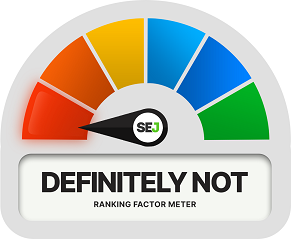You probably already know that your website’s coding can impact your search engine rankings.
You know that adding snippets for SEO, like a meta description, alt tags, and title tags, can significantly improve your visibility to search engines.
But, you may not have considered how the volume of code versus the amount of text on that page can affect your ranking.
It’s a concept known as “code-to-text ratio,” which can dramatically affect user experiences, page indexing, and page speed.
But what makes a good code-to-text ratio? And more importantly, how much does it factor into your search ranking?
The first question is easy to answer but has complex execution. A page should have just as much code as it needs and, at the same time, just as much content as the users need.
Focusing on the exact ratio is, in most cases, not necessary.
The second factor requires a deeper dive.
[Recommended Read:] The Complete Guide To Google Ranking Factors
The Claim: Search Engines Value Code-To-Text Ratios When Ranking Sites
There’s no question that your code-to-text ratio affects how visitors experience your website.
Sites that are too code-dense will have slower loading times, which can frustrate users and drive them away.
And websites with too little code may not provide enough information to a web crawler. And if search engines can’t determine what your page is about, they won’t be able to determine its content.
But do these issues also negatively impact your rankings?
The Evidence: Code-To-Text’s Effect On Search Engine Results Pages
In a 2018 Google Webmaster office-hours hangout, Google Webmaster Trends Analyst John Mueller was asked if the ratio of HTML code to website text had any role in determining rankings. He answered unequivocally, “no.”
So that’s it; case closed, right? Not so fast.
While Google does not directly consider the code-to-text ratio itself, several factors of that ratio support SEO best practices, which means a bad ratio can indirectly impact your search results placement.
Your code-to-text ratio can tell you which pages on your website need beefing up to give crawlers more information. If your code is too sparse, Google may have difficulty determining its relevance, which could cause the page to drop in search results.
On the other hand, sites that are overloaded with code may have slow loading times. Bloated and redundant HTML is particularly troublesome regarding page speed on mobile devices.
Faster loading times mean better user experiences, which is a significant ranking factor. You can use Core Web Vitals in Google Search Console to see how your SEO and UX work together.
Likewise, cluttered or disorganized code can be difficult for web crawlers to navigate when indexing. Clean, compact code is much easier for bots to traverse, and while this won’t have a massive effect on your rankings, it does factor in.
[Ebook Download:] Google Ranking Factors: Fact or Fiction
How To Fix Your Code-To-Text Ratio
At the end of the day, the main reason for improving your code-to-text ratio is to build a better user experience.
And that starts with validating your code. A tool like the W3C validator helps ensure your site is responsive and accessible while adhering to coding best practices.
It will help you identify invalid or redundant HTML code that needs to be removed, including all code that is not required to display the page and any code, commented out.
Next, you’ll want to evaluate your page loading time and look for areas of improvement. Google’s PageSpeed Insights Reports are great tools to use for this task.
Once you’ve identified problem areas, it’s time to fix them. If you can, avoid using tables on your pages, as they require an inordinate amount of HTML code. Use CSS for styling and formatting but place these elements in separate files wherever you can.
If you’re using Javascript or Flash, consider eliminating these elements. Finally, remove any hidden text and huge white spaces. Resize and compress your images, and keep your page size under 300 KB if possible.
The Verdict: Code-To-Text Isn’t A Ranking Signal, But Is Still Important To SEO

Do search engines directly include your code-to-text HTML ratio when deciding where your page will fall on search results pages? No.
But the quality of your coding, page load speed, and code-to-text ratio play an indirect role in SEO. More importantly, it affects how users experience your page.
Keep your code-to-text within the 25-70% ratio to ensure bloated code isn’t negatively impacting your website.
Featured Image: Paulo Bobita/Search Engine Journal





![AI Overviews: We Reverse-Engineered Them So You Don't Have To [+ What You Need To Do Next]](https://www.searchenginejournal.com/wp-content/uploads/2025/04/sidebar1x-455.png)